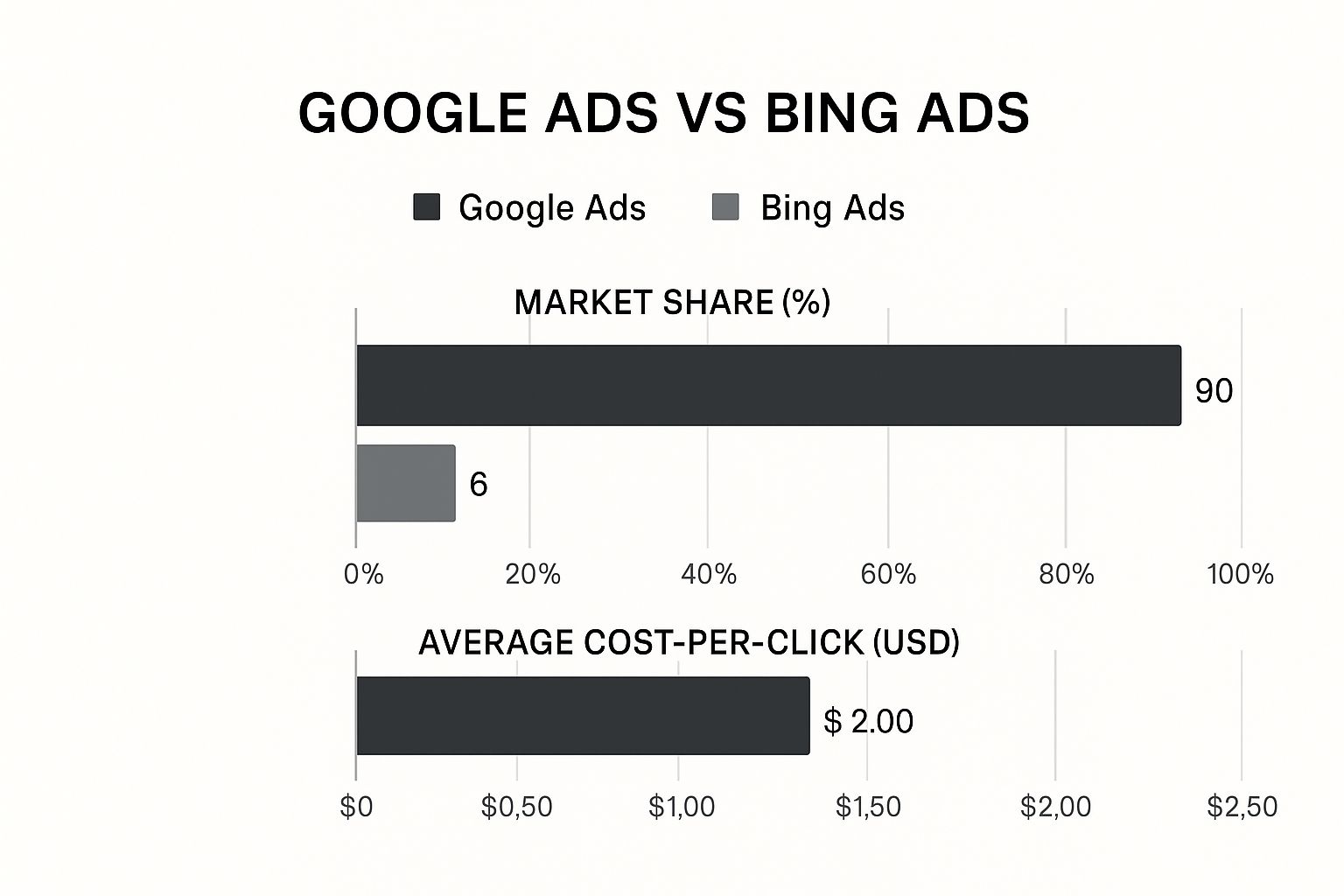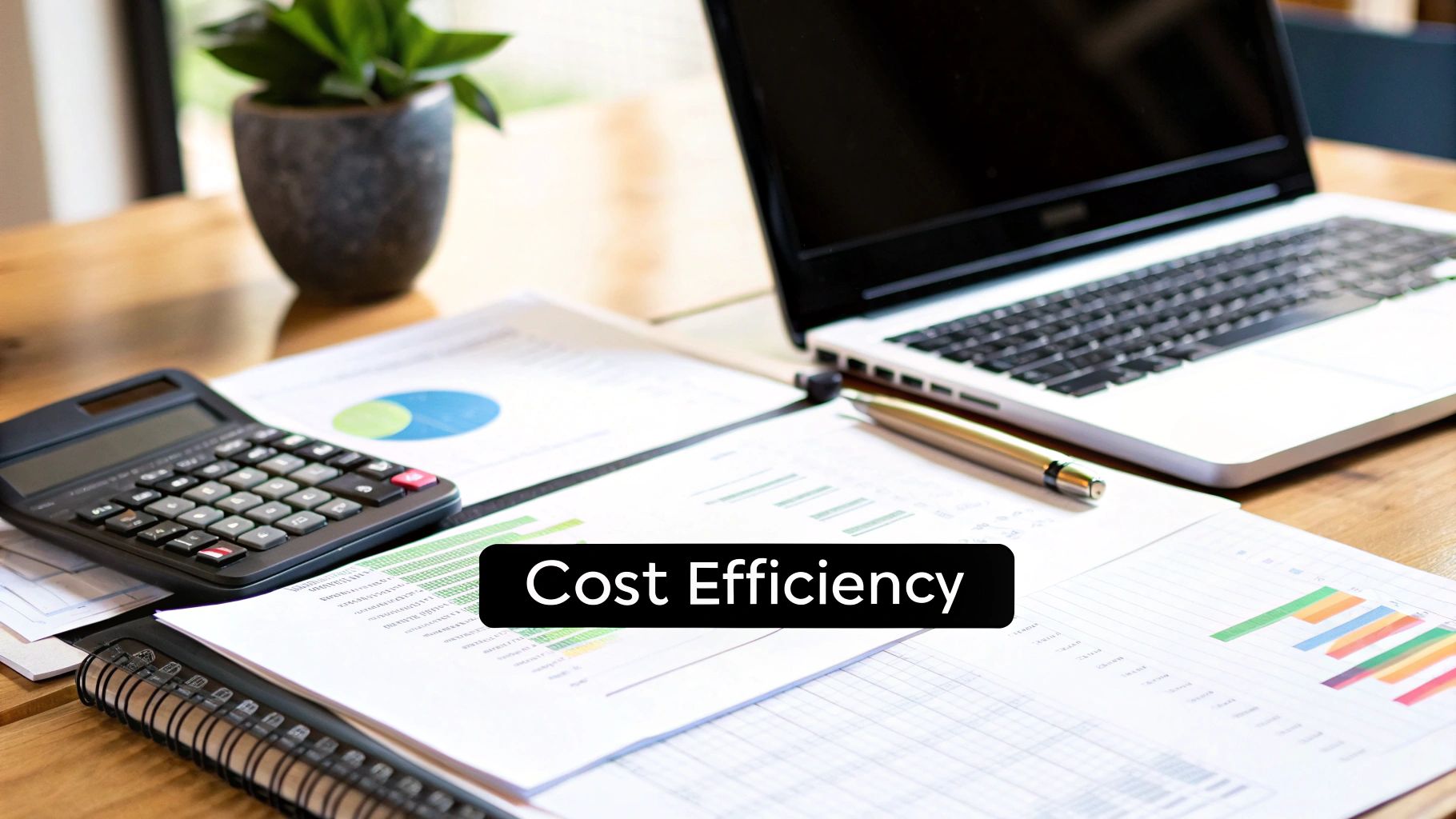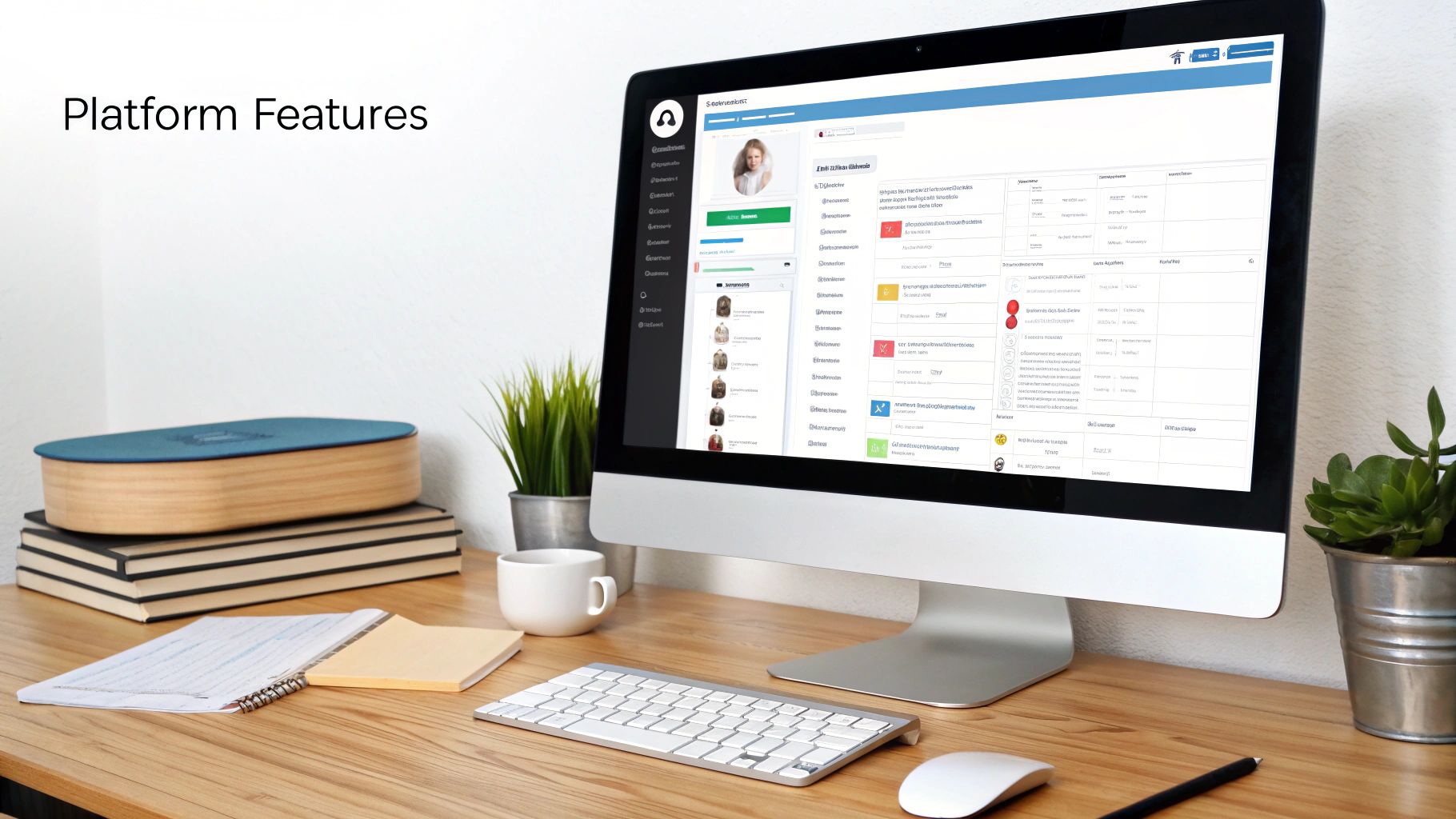Guide to Google Ads vs Bing Ads for UK Advertisers

When you’re weighing up Google Ads vs Microsoft Ads, it often boils down to a simple trade-off. Google gives you incredible reach and volume, whereas Microsoft can deliver lower costs and access to a very specific, professional audience. Discover more in this UK advertiser’s guide to Google Ads vs Bing Ads.
The real question isn’t which one is better, but which one is better for your business right now. Are you trying to cast the widest net possible, or are you hunting for a particular high-value niche?
Guide to Google Ads vs Bing Ads: Understanding the Advertising Titans
As you map out your paid search strategy, you have to get to grips with the core differences between the two main players. They both run on a pay-per-click (PPC) model, but they serve different slices of the market and offer unique advantages for UK businesses.
In the UK, Google Ads is the undisputed heavyweight, holding a massive market share of around 82%. This makes it the go-to platform for any advertiser needing to reach a huge, mobile-first audience.
On the other hand, Microsoft Advertising (what we used to call Bing Ads) carves out its own significant territory, especially on desktop searches. It often reaches an older, more affluent demographic. This makes it a surprisingly powerful and cost-effective tool for specific B2B campaigns, as you can discover in our full Microsoft vs Google Ads guide.
This infographic neatly breaks down the crucial differences in market share and average costs.
The numbers make it plain to see: Google dominates in sheer reach, but Microsoft clearly has an edge when it comes to a lower average cost-per-click.
At a Glance: Google Ads vs Bing Ads Key Differences
To make things even clearer, here’s a quick-reference table that sums up the core attributes of each platform for advertisers here in the UK.
| Attribute | Google Ads | Microsoft Advertising (Bing Ads) |
|---|---|---|
| Market Share (UK) | Dominant (~82%) | Smaller but significant (~12%) |
| Primary Audience | Broad, mobile-heavy, younger | Older, more affluent, B2B professionals |
| Typical CPC | Higher due to competition | Often lower, offering better value |
| Key Strength | Unmatched reach and search volume | Precise B2B targeting and higher ROAS |
| Best Use Case | Mass-market B2C, brand awareness | Niche B2B, budget-conscious campaigns |
This table gives you a solid foundation for your decision-making. Each platform has its place, and often, the smartest strategy involves using both to your advantage.
Microsoft’s integration with platforms like LinkedIn provides a strategic edge for UK advertisers. It allows direct targeting of professionals by job title, company, and industry, creating a valuable opportunity for cost-effective B2B campaigns focused on desktop users.
Guide to Google Ads vs Bing Ads: Audience Reach and Demographic Targeting
The biggest difference when you compare Google Ads vs Bing Ads isn’t hidden in a dashboard feature—it’s the people you can actually reach. Each platform connects you with a distinct audience, and getting your head around this is the first step to spending your budget wisely. Success here really boils down to matching your ideal customer to the search engine they’re most likely using.
Google’s main advantage is its colossal, unavoidable scale. It processes trillions of searches every year, and when you add YouTube and the entire Android ecosystem into the mix, you get access to an incredibly vast and varied audience. This user base tends to skew younger and is almost always on a mobile device, which is why it’s the go-to platform for most mass-market B2C brands.
Diving into Audience Profiles
Imagine a fast-fashion brand dropping a new collection aimed squarely at Gen Z. This demographic practically lives on their phones, binges video content on YouTube, and turns to Google for just about everything. For a brand like this, the sheer volume and mobile-first nature of the Google Ads network isn’t just a nice-to-have; it’s absolutely vital for growth.
Microsoft Advertising, on the other hand, tells a completely different story. Powered by the Microsoft Search Network (which includes Bing, Yahoo, and AOL), its audience is typically older, more affluent, and far more likely to be searching from a desktop computer—often in a professional setting. For many UK businesses, this represents a high-value slice of the market that’s frequently overlooked.
The secret weapon for Microsoft Ads is its exclusive integration with LinkedIn profile data. This lets you target users based on their company, job function, and industry. For B2B advertisers, this is an incredibly powerful feature that Google simply can’t match.
Aligning Your Strategy with Demographics (Guide to Google Ads vs Bing Ads)
This clear split in demographics practically writes your strategy for you. If you’re a financial services firm selling retirement plans or a B2B software company targeting enterprise-level clients, the Microsoft Ads audience is a perfect fit. These users aren’t just in the right age and income bracket; they’re often in a work mindset, searching on company computers during office hours.
Here’s how this might look in the real world for different types of businesses:
- B2C E-commerce (e.g., Streetwear Brand): Google is a must. Your campaign needs maximum exposure to a younger, trend-conscious audience that does most of its browsing and buying on a mobile.
- B2B Services (e.g., Legal Consultancy): Microsoft Ads gives you a strategic advantage. You can target partners at specific law firms using LinkedIn data on a platform they use at work, which can lead to highly qualified leads at a much lower cost-per-acquisition.
- Local Services (e.g., High-End Kitchen Fitter): A dual approach is often best. Use Google for broad local awareness to capture the majority of searchers, and then layer in Microsoft to specifically target older homeowners with more disposable income who are doing their research on a desktop.
Ultimately, choosing your platform has to start with a deep understanding of who you’re trying to sell to. While Google brings the crowd, Microsoft often delivers a more curated, professional audience that can be gold dust for the right business.
Analysing Cost, Competition, and Return on Investment
Let’s get down to what really matters: your budget and the return it generates. When you put Google Ads and Microsoft Advertising side-by-side, the financial reality of each platform becomes crystal clear. It’s never just about spending less money; it’s about putting your budget where it will work the hardest for you.
There’s no getting around it—Google’s enormous audience creates a fiercely competitive auction. With more advertisers fighting for the same eyeballs and top ad spots, the average Cost-Per-Click (CPC) is almost always higher, no matter your industry. This pressure cooker environment demands a laser-focused strategy and, often, a bigger wallet just to get seen.
Cost and Performance in the UK Market (Guide to Google Ads vs Bing Ads)
On the other hand, Microsoft Ads often presents a more budget-friendly alternative. Fewer advertisers mean less competition for keywords, which has a direct and positive impact on your CPCs. For many UK businesses, particularly those in pricey sectors like finance or legal services, this can be the difference between a profitable campaign and one that just drains cash.
To give you a clearer picture, let’s break down how these financial metrics typically stack up for advertisers here in the UK.
Cost and Performance Metrics: UK Market
This table gives a general idea of the differences you can expect when forecasting your ad spend and potential returns on each platform.
| Metric | Google Ads | Microsoft Advertising (Bing Ads) |
|---|---|---|
| Average CPC | Higher due to immense competition. | Often 30-50% lower than Google Ads. |
| Competition Level | Very High. | Low to Medium. |
| Conversion Rate | Varies widely; often strong for mobile-first B2C. | Can be higher, especially for desktop and specific B2B niches. |
| Typical ROAS | Can be strong, but often squeezed by high CPCs. | Frequently higher due to the lower initial ad spend. |
The key takeaway here isn’t just about cost. While Google delivers sheer volume, Microsoft Ads frequently provides better value. A lower CPC means your budget goes further, buying more clicks—and more chances to convert—for the exact same investment.
This cost difference is a game-changer for SMEs and any business working with a tight marketing budget. While Google dominates the search landscape, Microsoft Ads serves a significant and often overlooked audience of 53 million UK desktop users who don’t use Google as their primary search engine. This lets savvy advertisers tap into a less crowded marketplace, often leading to a much better return, especially if your customers are primarily on desktop.
Of course, cheap clicks are worthless if they don’t convert. To truly squeeze every drop of value from your traffic, regardless of the platform, you must have a solid foundation built on effective landing page design. A clunky or confusing user experience will kill your ROI faster than anything else.
Ultimately, your Return on Ad Spend (ROAS) hinges on finding that sweet spot of profitability, which takes time and testing. If you’re wondering about what to expect timeline-wise, our guide on how long it takes for Google Ads to work offers some practical insights.
Guide to Google Ads vs Bing Ads: Comparing Platform Features and Management Tools
The day-to-day grind of managing your campaigns has a huge impact on your results. When you get into the nitty-gritty of Google Ads vs Bing Ads, you’ll see that while they’re built on a similar foundation, the tools and features are tailored for slightly different people and skill sets.
For anyone just starting out, the Google Ads interface can feel a bit like stepping into a cockpit. There are a lot of dials and switches. But that complexity is also its biggest advantage, giving you incredible control over every tiny detail of your campaigns. Honestly, Google’s suite of management tools is just more advanced, particularly when it comes to its AI.
Google’s AI-powered smart bidding strategies, like Target CPA or Maximise Conversion Value, are in a league of their own. They crunch thousands of real-time signals to fine-tune bids, a level of automation that Microsoft is still catching up with.
This level of sophisticated automation is a massive help for advertisers looking to scale campaigns efficiently. It’s a key part of maximising Google Ads ROI for UK brands, as it processes huge volumes of data to sniff out conversion opportunities you’d never find manually.
Ease of Management and Campaign Import
Microsoft Ads hits back with a focus on simplicity. Its interface is widely seen as more straightforward and a lot less intimidating for PPC newcomers. But its real killer feature is the seamless Google Ads import tool.
With just a few clicks, you can lift your existing campaigns, ad groups, and keywords straight from Google and drop them into Microsoft Ads. This makes dipping your toes into the Microsoft network incredibly easy for any business already running on Google. It removes so much of the initial friction.
Let’s break down a few key tool differences:
- Keyword Research: Google’s Keyword Planner is the powerhouse here, armed with more robust data and forecasting simply because of its colossal search volume. Microsoft’s tool is still very useful, but its insights are drawn from its smaller, more specific user base.
- Reporting Dashboards: Both platforms give you detailed reports, but Google’s native integration with Google Analytics offers much deeper insights into what users do after they click. Microsoft’s reporting is clean and to the point, and many advertisers praise its user-friendly layout.
- Automation & Bidding: Google is the clear leader with its sophisticated, AI-driven bidding. Microsoft offers solid automated options, but they just don’t have the same machine-learning firepower behind them.
At the end of the day, Google offers a beast of a toolkit for experienced advertisers who need granular control and cutting-edge automation. Microsoft, on the other hand, provides a more streamlined, user-friendly experience with an absolute gift of an import feature, making it the perfect complementary platform for anyone looking to expand their reach without starting from square one.
Guide to Google Ads vs Bing Ads: When Should You Put Google Ads First?
While running ads on both platforms is often the smart play, some situations demand that your budget and effort go straight to Google Ads. If your campaign hinges on hitting maximum scale and doing it quickly, Google is almost always the place to start. Its sheer size makes it a must-have for certain goals.
Think about a big product launch for a B2C item aimed at the mass market. Your main objective is to blast out brand awareness and grab as much attention as you can, as fast as possible. In a scenario like this, the colossal search volume on Google—which simply dwarfs its rivals—gives you an unbeatable platform for instant visibility.
The same logic holds if your target customer is young and glued to their mobile phone. For sectors like fast fashion, mobile gaming, or consumer tech, the audience practically lives inside Google’s ecosystem.
Key Reasons to Go with a Google-First Strategy
Sometimes, your campaign needs specific features that only Google can offer. It gives you access to tools and audiences that Microsoft just can’t match, making it the only logical choice for certain strategies.
You should prioritise Google Ads when your strategy is built around:
- Massive Reach: For national brand awareness campaigns, you need to cast the widest net possible. With Google holding a staggering 82% market share in the UK, it’s the default choice for reaching the largest audience.
- YouTube Advertising: If video is a central part of your marketing mix, you simply have to be on YouTube. Tapping into its audience of over two billion logged-in monthly users is a massive opportunity for visual storytelling and product demos.
- Advanced Machine Learning: For big, complex campaigns with hefty budgets, Google’s sophisticated AI is a powerhouse. Its Performance Max campaigns, in particular, can analyse thousands of signals to optimise bids and hunt down conversions at a scale you could never replicate manually.
If your business model is all about high volume and impulse buys, or you need to completely own the search results for a trending topic, Google’s scale and speed are your best friends. It’s built for impact.
Ultimately, choosing to start with Google is a strategic call. It’s driven by the need for unmatched reach, access to specific channels like YouTube, or the desire to use the most advanced automation tools out there.
Guide to Google Ads vs Bing Ads: When Does Microsoft Advertising Have the Edge?
While Google’s sheer scale is undeniable, Microsoft Advertising shines in specific, high-value scenarios. Choosing Microsoft isn’t about ditching Google altogether; it’s a savvy move to capture an audience that Google’s wide net might miss, or one that’s too expensive to reach on that platform. It’s the ideal choice when precision and budget efficiency are more important than pure volume.
The most compelling argument for Microsoft Ads is its exclusive access to LinkedIn profile data. This is a genuine game-changer for B2B marketers. Instead of just bidding on keywords, you can target users based on their company, specific industry, and even their exact job function.
Targeting High-Value Niches
Let’s say you’re a UK firm selling compliance software to finance directors. On Google, you’d be bidding on broad keywords, crossing your fingers that the right person clicks. With Microsoft Ads, you can build a campaign that only targets users with “Finance Director” in their LinkedIn profile. The quality of your leads goes through the roof. That level of precision is priceless.
Microsoft Ads also really comes into its own for businesses with tight budgets. With far less competition, the average cost-per-click (CPC) is often significantly lower. This means your budget stretches much further, a huge advantage in expensive niches. You can get a much better Return on Ad Spend (ROAS) simply because you’re not paying as much for each click.
For advertisers whose ideal customers are a bit older, more affluent, and tend to do their research on a desktop computer, Microsoft’s network is a goldmine. This demographic often has more disposable income and is frequently in a professional headspace when they’re searching.
This makes Microsoft Ads the go-to platform in several key situations:
- B2B Lead Generation: Targeting decision-makers directly using that powerful LinkedIn data.
- High-Value Services: Reaching affluent homeowners for things like bespoke kitchen renovations or financial planning.
- Desktop-First Audiences: Capturing users in office environments or those who simply prefer doing their research on a proper computer.
As Microsoft continues to develop its platform, its features are becoming more and more aligned with Google’s. You can see this in action with how Microsoft Advertising is rolling out Performance Max campaigns to bring more automation and optimisation to its network. When your goal is targeted efficiency over mass-market reach, Microsoft Ads presents a clear strategic advantage.
Frequently Asked Questions: Guide to Google Ads vs Bing Ads
When you’re weighing up Google Ads and Microsoft Ads, a few common questions always pop up, especially for UK businesses trying to get the most out of every pound spent. Let’s get them answered.
Can I Use My Google Ads on Bing?
Yes, you absolutely can. Microsoft Advertising has a brilliant import tool that lets you pull your existing campaigns straight from Google Ads. It’s a massive time-saver.
With just a few clicks, you can transfer your ad groups, keywords, and settings. It’s easily the quickest way to dip your toe in the water on Microsoft’s network without having to build everything from the ground up.
But it’s not a simple “set and forget” job. Once you’ve imported everything, you must review and tweak your bids, targeting, and ad copy. What works wonders on Google might need a slight adjustment to hit the mark on Bing, especially considering the different audience and lower average CPCs.
Is Bing Ads Cheaper Than Google Ads?
Generally speaking, yes. The main reason comes down to one thing: less competition.
With fewer advertisers fighting over the same keywords, the average cost-per-click (CPC) on Microsoft Ads can be 30-50% lower than what you’d pay on Google. For UK businesses in really competitive spaces like finance or law, that cost difference can make a huge impact on your Return on Ad Spend (ROAS).
A cheaper click is great, but its real value depends entirely on your audience. A lower CPC only becomes a genuine advantage when you’re reaching users who are actually going to convert.
Which Platform Is Better for Local UK Businesses?
This really depends on your type of business and who you’re trying to reach.
For a local service with a wide-ranging customer base, like a plumber or a popular takeaway, Google Ads is pretty much essential. You need to be there to capture the sheer volume of local searches, and its “Local” campaigns are built specifically to drive footfall and phone calls.
On the other hand, if you’re a local business serving a high-value, niche market—think a bespoke tailor or a financial advisor targeting affluent postcodes—Microsoft Ads could be your secret weapon. You can often reach an older, wealthier demographic for a lower cost, delivering more qualified leads for your budget. The smartest strategy often involves using both platforms for different goals.
Ready to stop guessing and start getting real results from your paid search campaigns? The expert team at PPC Geeks creates data-driven strategies for both Google and Microsoft Ads, ensuring you get the most out of every pound spent. Find out how we can help by visiting https://ppcgeeks.co.uk.
Author
Search Blog
Free PPC Audit
Subscribe to our Newsletter
The Voices of Our Success: Your Words, Our Pride
Don't just take our word for it. With over 100+ five-star reviews, we let our work-and our satisfied clients-speak for us.
"We have been working with PPC Geeks for around 6 months and have found Mark and the team to be very impressive. Having worked with a few companies in this and similar sectors, I rate PPC Geeks as the strongest I have come across. They have taken time to understand our business, our market and competitors and supported us to devise a strategy to generate business. I value the expertise Mark and his team provide and trust them to make the best recommendations for the long-term."
~ Just Go, Alasdair Anderson



